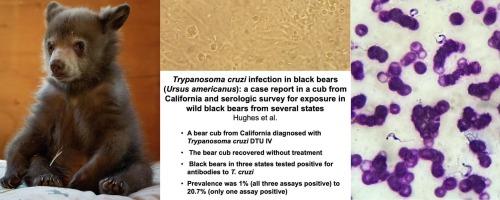Trypanosoma cruzi infection in American black bears (Ursus americanus): A case report in a cub from California and serologic survey for exposure in wild black bears from several states
IF 1.4
Q3 PARASITOLOGY
Veterinary parasitology, regional studies and reports
Pub Date : 2024-09-28
DOI:10.1016/j.vprsr.2024.101129
引用次数: 0
Abstract
Trypanosoma cruzi is an important cause of disease and death in humans and dogs, and although wildlife infections are common, less is known about disease manifestations. A 12-week-old male American black bear (Ursus americanus) cub with mild lethargy and anorexia presented to a wildlife rehabilitation center in Lake Tahoe, California. The cub continued to become increasingly weak and showed decreasing interest in play and other activities. The cub was anemic and had increased γ-glutamyltransferase (GGT) liver enzymes. A large number of trypanosomes were noted on a thin blood smear. Trypanosoma cruzi was isolated in culture from a subsequent blood collection. Proliferative bony lesions were noted on radiographs, but this finding was considered unrelated to the T. cruzi infection. The number of parasites observed in thin blood smears dramatically dropped over time, but it remained PCR positive until at least nine months. The cub continued to gain weight and became increasingly active. Serum samples from the cub were positive with three different serologic assays (IFA, ELISA, and ICT). The bear was not treated because of the decreasing parasitemia and the improvement in activity and appetite. Although the bear could not be released due to issues unrelated to T. cruzi, it remains healthy in a captive facility. Sequence analysis of the DHFR-TS and COII-ND1 gene sequences confirmed the bear was infected with DTC TcIV. Following the detection of this clinical case, a serologic survey was conducted to determine the prevalence of T. cruzi exposure of black bears in California, North Carolina, and Pennsylvania. Because no serologic assay has been validated for use in bears, three different assays were used. Marked differences in apparent seroprevalence range from 1% (requiring all three assays to be positive) to ∼20.7% (requiring only one assay to be positive). Black bears are naturally exposed to T. cruzi across the United States. Future studies using PCR testing of tissues or blood would be needed to better understand the prevalence of T. cruzi in wild black bears, lineages most commonly associated with infection, and if T. cruzi represents a health threat to bears.

美洲黑熊(Ursus americanus)中的克鲁兹锥虫感染:加利福尼亚州一只幼熊的病例报告以及对几个州野生黑熊暴露情况的血清学调查
克鲁兹锥虫是导致人类和狗生病和死亡的重要原因,虽然野生动物感染克鲁兹锥虫很常见,但人们对疾病的表现却知之甚少。一只 12 周大的雄性美洲黑熊(Ursus americanus)幼崽因轻度嗜睡和厌食症来到加利福尼亚州太浩湖的一家野生动物康复中心。幼熊的身体越来越虚弱,对玩耍和其他活动的兴趣也越来越小。幼熊贫血,γ-谷氨酰转移酶(GGT)肝酶升高。在稀薄的血液涂片上发现了大量锥虫。从随后采集的血液中培养分离出了克鲁斯锥虫。X光片上发现了增生性骨质病变,但这一发现被认为与克鲁兹锥虫感染无关。随着时间的推移,在稀薄的血液涂片中观察到的寄生虫数量急剧下降,但至少在九个月之前,它的 PCR 一直呈阳性。幼熊的体重继续增加,变得越来越活泼。幼熊的血清样本在三种不同的血清检测方法(IFA、ELISA 和 ICT)中均呈阳性。由于寄生虫血症的下降以及活动和食欲的改善,该黑熊没有接受治疗。尽管由于与T. cruzi无关的问题,该黑熊未能被释放,但它在圈养设施中仍然健康。对 DHFR-TS 和 COII-ND1 基因序列的序列分析证实,这只熊感染了 DTC TcIV。在发现该临床病例后,我们进行了血清学调查,以确定加利福尼亚、北卡罗来纳州和宾夕法尼亚州黑熊的 T. cruzi 感染率。由于还没有针对黑熊的有效血清检测方法,因此使用了三种不同的检测方法。明显的血清阳性率差异从 1%(需要三种检测方法均呈阳性)到 20.7%(只需要一种检测方法呈阳性)不等。美国各地的黑熊都会自然接触到T. cruzi。为了更好地了解T. cruzi在野生黑熊中的流行情况、最常与感染相关的品系,以及T. cruzi是否对黑熊的健康构成威胁,需要在今后的研究中使用PCR检测组织或血液。
本文章由计算机程序翻译,如有差异,请以英文原文为准。
求助全文
约1分钟内获得全文
求助全文
来源期刊
CiteScore
2.90
自引率
7.10%
发文量
126
审稿时长
97 days
期刊介绍:
Veterinary Parasitology: Regional Studies and Reports focuses on aspects of veterinary parasitology that are of regional concern, which is especially important in this era of climate change and the rapid and often unconstrained travel of people and animals. Relative to regions, this journal will accept papers of the highest quality dealing with all aspects of disease prevention, pathology, treatment, epidemiology, and control of parasites within the field of veterinary medicine. Also, case reports will be considered as they add to information related to local disease and its control; such papers must be concise and represent appropriate medical intervention. Papers on veterinary parasitology from wildlife species are acceptable, but only if they relate to the practice of veterinary medicine. Studies on vector-borne bacterial and viral agents are suitable, but only if the paper deals with vector transmission of these organisms to domesticated animals. Studies dealing with parasite control by means of natural products, both in vivo and in vitro, are more suited for one of the many journals that now specialize in papers of this type. However, due to the regional nature of much of this research, submissions may be considered based upon a case being made by the author(s) to the Editor. Circumstances relating to animal experimentation must meet the International Guiding Principles for Biomedical Research Involving Animals as issued by the Council for International Organizations of Medical Sciences (obtainable from: Executive Secretary C.I.O.M.S., c/o W.H.O., Via Appia, CH-1211 Geneva 27, Switzerland).

 求助内容:
求助内容: 应助结果提醒方式:
应助结果提醒方式:


